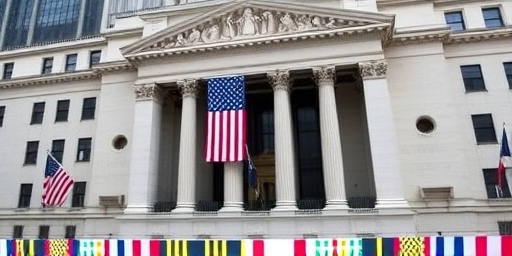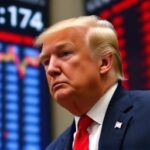In a dramatic turn that sent Wall Street soaring, the US stock market reached unprecedented heights on Wednesday as Federal Reserve Chair Jerome Powell signaled a potential pause on further rate cuts this December. The Dow Jones Industrial Average climbed over 400 points, closing at a fresh all-time high of 42,500, while the S&P 500 and Nasdaq Composite also shattered records, gaining 1.2% and 1.8% respectively. This surge came on the heels of Powell’s remarks during a press conference following the Fed‘s latest policy meeting, where he emphasized the cooling inflation trends but cautioned against rushing into additional monetary easing.
Investors, who had been bracing for more aggressive rate cut expectations, instead celebrated the clarity and stability in the Fed‘s approach. The decision reflects a delicate balance: inflation has eased to 2.5% year-over-year from peaks above 9% in 2022, yet the central bank remains vigilant against any resurgence that could undermine economic recovery. This pivot from anticipated rate cuts has injected fresh optimism into the stock market, with sectors like technology and consumer goods leading the charge.
Powell’s Cautious Stance on December Rate Cuts
Federal Reserve Chair Jerome Powell’s comments during the post-meeting press conference were the catalyst for the day’s market euphoria. Speaking from the Fed‘s headquarters in Washington, D.C., Powell stated, “While inflation has made significant progress toward our 2% target, we must remain data-dependent. A rate cut in December is not off the table, but current indicators suggest a pause could be prudent to assess the full impact of our previous actions.” This nuanced language eased fears of overstimulating the economy, which some analysts had warned could reignite inflationary pressures.
The Fed’s benchmark interest rate currently sits at 4.75% to 5%, following three consecutive 25-basis-point reductions earlier this year. Powell highlighted recent economic data, including a softer-than-expected jobs report and declining energy prices, as key factors in the cooling inflation narrative. However, he also pointed to persistent wage growth in service sectors as a potential sticky point. This balance act underscores the Fed’s shift from aggressive hiking cycles to a more measured path forward.
Market participants interpreted Powell’s words as a signal of policy normalization rather than tightening, which alleviated concerns about recession risks. Bond yields dipped slightly, with the 10-year Treasury note falling to 4.1%, further bolstering equity valuations. Economists at major firms like Goldman Sachs noted that this pause could extend into early 2025, depending on upcoming consumer price index (CPI) releases.
Record-Breaking Gains Across Wall Street Indices
The stock market’s response was swift and robust, with the S&P 500 notching its seventh record close in the past month. Tech giants such as Apple, Nvidia, and Microsoft propelled the Nasdaq’s surge, as investors rotated back into growth stocks amid expectations of sustained low inflation. Nvidia alone added over $100 billion in market cap, driven by AI optimism and the Fed’s reassuring tone on economic stability.
The Dow’s blue-chip components, including financials like JPMorgan Chase and industrials such as Boeing, also posted strong gains. JPMorgan shares rose 2.3% after the bank’s CEO, Jamie Dimon, echoed Powell’s sentiments in a separate earnings call, stating that a stable rate environment would support lending growth without fueling asset bubbles. In contrast, rate-sensitive sectors like real estate investment trusts (REITs) saw modest dips, as the pause news tempered hopes for deeper borrowing cost reductions.
- Dow Jones Industrial Average: +1.0% to 42,500
- S&P 500: +1.2% to 5,980
- Nasdaq Composite: +1.8% to 19,200
- Russell 2000 (small caps): +0.8%, reflecting broader market participation
Trading volume spiked to 12 billion shares, the highest in weeks, indicating widespread investor confidence. Analysts attribute this rally to the interplay between the Fed’s rate cut pause and positive corporate earnings seasons, where over 80% of S&P 500 companies have beaten expectations so far this quarter.
Investor Enthusiasm Fuels Optimism Amid Inflation Cool-Down
Wall Street’s bulls roared back to life as the Fed’s signal on pausing rate cuts aligned with fresh data showing inflation’s continued moderation. The latest Producer Price Index (PPI) report, released earlier this week, indicated a 0.1% monthly decline in wholesale prices, the lowest in over a year. This reinforced the narrative of disinflation, allowing the stock market to focus on growth prospects rather than monetary policy uncertainties.
Prominent investors voiced their approval. Warren Buffett’s Berkshire Hathaway, which holds significant stakes in consumer and financial stocks, saw its shares climb 1.5%. In a recent interview with CNBC, BlackRock CEO Larry Fink commented, “The Fed’s prudent approach to rate cuts is exactly what markets need—stability without complacency. With inflation trending down, we’re positioned for a soft landing.” Retail investors, via platforms like Robinhood, piled into ETFs tracking the S&P 500, with inflows reaching $5 billion in a single day.
However, not all reactions were uniformly positive. Some economists warn that a prolonged rate cut pause could strain highly leveraged companies. The VIX volatility index, often called the ‘fear gauge,’ dropped to 15, its lowest since summer, signaling reduced market anxiety. Sector-wise, energy stocks lagged due to falling oil prices, but healthcare and utilities provided defensive support, gaining 0.5% and 0.7% respectively.
Global markets echoed the sentiment, with Europe’s Stoxx 600 up 0.9% and Asia’s Nikkei 225 advancing 1.2% in early trading. This interconnected rally highlights how the Fed’s decisions ripple worldwide, particularly as international inflation rates also ease.
Economic Data Driving the Fed’s Inflation-Focused Strategy
At the core of the Fed’s decision to signal a rate cut pause lies a robust body of economic data painting a picture of controlled inflation without derailing growth. The Consumer Price Index (CPI) for October clocked in at 2.5%, down from 2.6% in September and well below the 3.7% recorded a year ago. Core inflation, excluding volatile food and energy, held steady at 3.2%, giving policymakers breathing room.
Unemployment remains low at 4.1%, with nonfarm payrolls adding 206,000 jobs last month—solid but not overheated. The Fed’s preferred gauge, the Personal Consumption Expenditures (PCE) index, is expected to show similar trends in Friday’s report, potentially solidifying the pause narrative. Powell referenced these metrics in his remarks, noting, “Inflation is cooling, but we can’t declare victory yet. Our rate cut decisions will hinge on sustained progress.”
Broader context includes supply chain normalization post-pandemic and geopolitical factors like the Middle East tensions, which have kept energy prices in check despite initial spikes. The US housing market, a bellwether for inflation, saw mortgage rates stabilize around 6.5%, encouraging modest homebuying without the frenzy of 2021.
Critics from the progressive wing argue the Fed should prioritize employment over inflation hawkishness, but Powell countered by emphasizing dual mandates. Historical parallels to the 1990s, when the Fed under Alan Greenspan paused hikes amid falling inflation, offer a optimistic lens— a period that preceded the dot-com boom.
- Review key inflation reports: CPI, PPI, PCE
- Assess labor market health: Jobs data and wage trends
- Monitor global influences: Oil prices and trade dynamics
This data-driven approach has restored some faith in the Fed after years of volatile policy shifts, contributing to the stock market’s resilience.
Looking Ahead: Implications for Investors and Policy Shifts
As the dust settles on this latest Fed meeting, eyes turn to the horizon where the implications of a potential rate cut pause could reshape investment strategies and economic trajectories. Market forecasters now peg the odds of a December rate cut at just 40%, down from 70% a week ago, per CME FedWatch Tool data. This recalibration suggests a higher-for-longer rate environment, benefiting savers through better yields on bonds and CDs while challenging borrowers in auto and credit card sectors.
For the stock market, the pause could sustain the bull run if corporate profits continue to outpace expectations. Analysts at Morgan Stanley project S&P 500 earnings growth of 12% in 2025, fueled by productivity gains from AI and deregulation prospects under a potential new administration. However, risks loom: any inflation rebound from holiday spending or supply disruptions could prompt the Fed to reconsider its stance, potentially leading to volatility.
Investors are advised to diversify, with a tilt toward quality stocks and inflation-hedges like commodities. Pension funds and 401(k) holders stand to gain from the rally, but experts urge caution against overexposure to tech amid valuation concerns. Internationally, emerging markets may see capital inflows as US rates stabilize, boosting currencies like the Brazilian real.
Upcoming events, including the November jobs report and Thanksgiving retail sales data, will be pivotal. If inflation keeps cooling, the Fed might resume rate cuts in early 2025, extending the economic expansion now in its 13th year. Powell’s closing remark encapsulates the forward path: “We’re navigating uncharted waters, but with careful steering, we can achieve both price stability and robust growth.” This outlook positions the stock market for continued gains, provided the Fed’s signals hold true.









